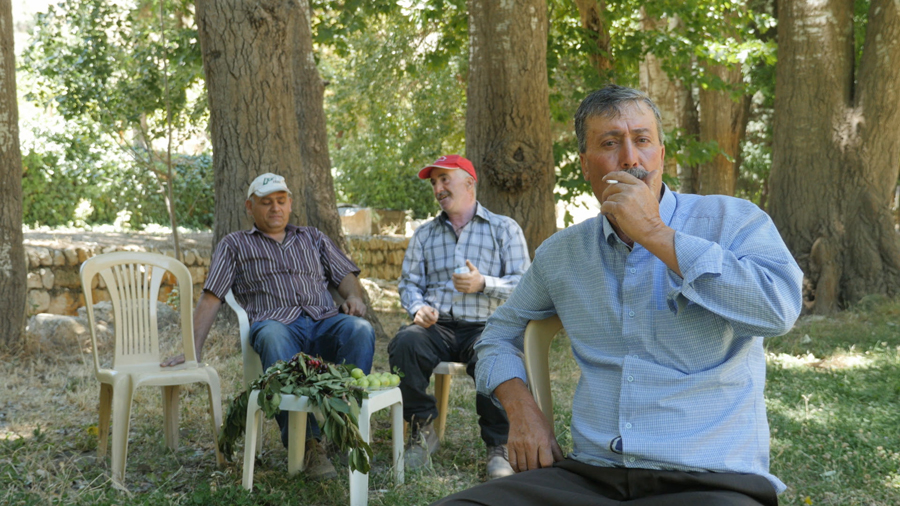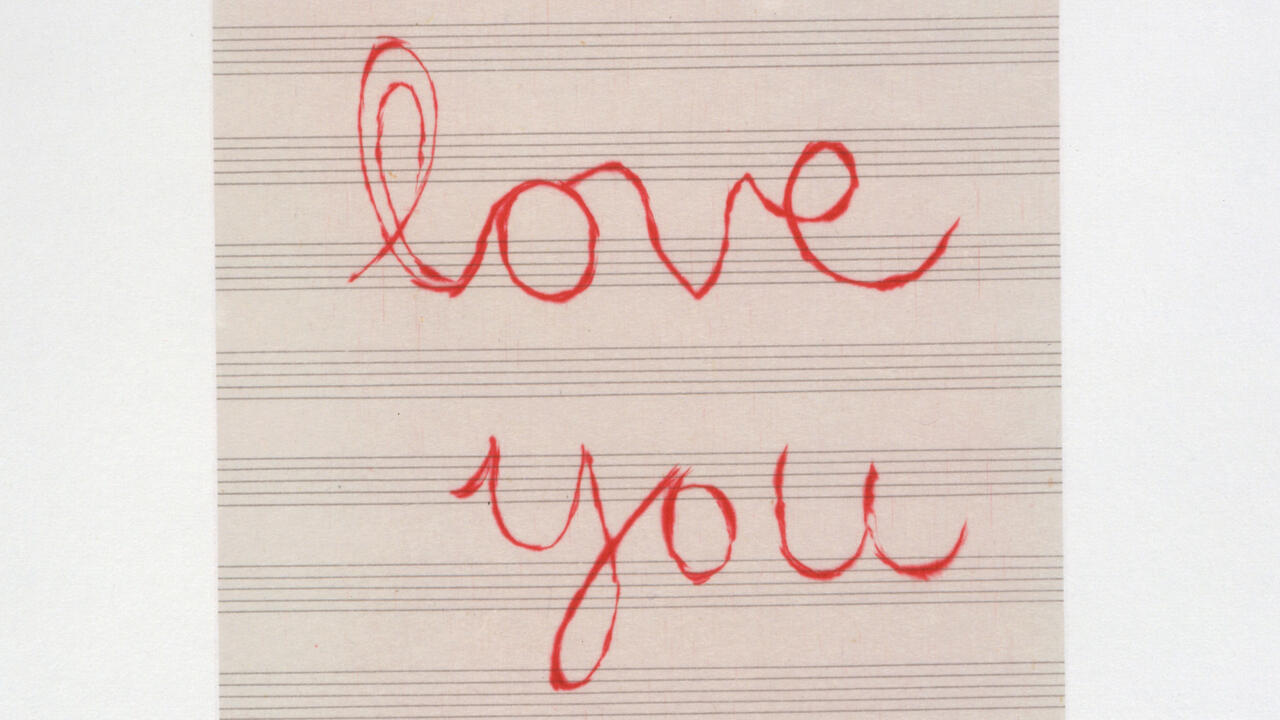One Take: The Drift
A new film by Maeve Brennan reflects on lives caught up in the conflict in Lebanon
A new film by Maeve Brennan reflects on lives caught up in the conflict in Lebanon

It starts, as so much does, with a long road.
In the distance, a BMW eases through a chicane and onto a tarmac straight, its destination out of shot. The car approaches from a mountain range and is moving quickly, but we watch from a distance, so it seems lethargic. It nears, banks left; the camera, doting, moves with it. The driver is Mohammad, a young mechanic, joyrider and one of a handful of characters brought together in The Drift, the latest film by London- and Beirut-based artist Maeve Brennan. Mohammad lives in Britel, a small settlement in the Beqaa Valley that skirts Lebanon’s eastern flank. The town has a reputation. Famed for an economy of stolen cars, accessible via several tareekh tuffar (outlaw roads) and familiar to those smuggling antiquities from Syria, it was recently described in Beirut’s Daily Star newspaper as ‘synonymous with crime’. A touch dramatic, perhaps, but there are certainly stolen cars (Mohammad runs his own garage) and there are certainly outlaws (Mohammad’s one of them).

It starts, as so much does, with a history.
Fakhry, a man in his 60s whose hair is yielding to grey, stares into the camera for slightly too long and turns: ‘Give me a cigarette.’ The men behind him laugh, oblige and leave. Fakhry, speaking quickly, words punctuated with gestures, talks of Beqaa’s Roman temples, several of which he has guarded since the 1970s; of his father, a gatekeeper before him; and of the thieves who regularly threaten these sites. Here, he falters, looking to the distance, a hand on his chest. ‘It became part of me,’ he says, eyes on the unseen. ‘What can I tell you? Perhaps my blood has turned to ruins.’ To trail Fakhry through one of these sites is to watch an ageing man reminisce with lifelong friends: weathered stone slabs become young; fallen columns, drawn from the earth, are fit for purpose once more. Fakhry does, on occasion, speak of the destruction of his friends, these temples, but his lamentations are often checked by proud tributes to their resilience. Whether these reassurances are for monument or man is ambiguous, but never in doubt is Fakhry’s deep connection to these sites – to their materials and the histories they preserve. ‘I know where each rock belongs. These days, they don’t.’
It starts, as so much does, with a crack.
As he moves his hands around the broken mouth of a pot, Hashem’s breathing is almost audible. He thumbs a fissure, putting skin to edge as if learning every contour, caring for every wound. Lit by a window, he reaches down and picks up another fragment. Turning both over in his hands, he searches for a common angle.

Hashem is a self-taught archaeologist operating from the basement of the American University of Beirut, where he has worked for 25 years. His job, which he conducts in silence, is to reassemble the innumerable fragments of pottery that were unearthed in post-civil war Beirut. Armed with layman’s tools – superglue, scalpel, toothbrush – he sits and repeats that same process: find, touch, repair.
The Drift is not an explicitly political film. In its 55 or so minutes, it peddles no agenda, its characters rarely speak of anything but the quotidian objects in their hands, and its cuts are so quick-fire that we are denied the opportunity to assemble the narrative necessary to empathize or condemn. But, by virtue of its being shot entirely in Lebanon, The Drift finds its every character, sound and shadow haunted by the spectre of conflict.
Officially, a civil war consumed Lebanon between the years of 1975 and 1990 and – depending on your report of choice – claimed the lives of between 150,000 and 250,000 people. But to recall the conflict in such base terms (and round numbers) is to overlook both its savagery and its baffling complexity. This so-called civil war involved over 20 internal militias, several of which were proxy paramilitaries, and drew in armies from Syria, Israel and the US. It spread to each cardinal point, involved massacres, retaliatory massacres, car bombings, retaliatory car bombings and assassinations, and left in its wake a diaspora so implausibly large that its true magnitude will never be known.

Since the war’s alleged end date, the situation in Lebanon has improved, with the core confessional groups maintaining the delicate balance that peace demands. But it’s hard to defend against aftershocks. Michel Aoun, the current president, is repeatedly accused of having committed war crimes in the 1980s. Volatility also prowls the gates. To the north: Aleppo, and the fallout from the worst humanitarian crisis since World War II. To the south: Israel, where Trump’s unbounded recklessness has seen him propose a relocation of the US embassy from Tel Aviv to Jerusalem, a move that would severely undermine the possibility of a two-state solution.
Brennan’s refusal to make these actualities explicit is not a refusal to acknowledge, for it is the traces of this history that inextricably bind our characters, and those on the film’s fringes: an ‘antiques dealer’ whose plant pots are sarcophagi; a smuggler, who rattles through his catalogue raisonné on a Samsung Galaxy. Mohammad lifts a spare door from a scrapyard; Fakhry comforts a second-century relief; Hashem holds a fragment to the light: each of these objects preserves a war that was; each act of salvage is one choreographed by a conflict removed. That word ‘salvage’ is double-headed here, pertaining to both a practical need to rebuild and a deeper desire for reconstitution, catharsis and progression. As Elias Khoury writes in his novel Gate of the Sun (1998): ‘We remember in order to forget.’
In addressing conflict so obliquely, Brennan not only undermines its authority, but also taps into the way in which the majority interact with this conflict: from a distance. This is not a physical distance (The Drift is punctuated by military helicopters, men with guns at their backs) but an emotional one; the kind experienced following the normalization of something abnormal. Maybe ‘from a distance’ is the wrong phrase; maybe it’s ‘from a position of numbness’.

This numbness is present when, perched in the back of Mohammad’s car, we pass a monument to Ali Saleh, a Hezbollah leader who was killed by a car bomb in Beirut’s Dahiya neighbourhood in 2003, the victim of a Mossad-backed assassination cell. The monument is acutely politicized in its refusal to deny the brutality of Saleh’s death. On faded concrete sits a BMW 525, its windows blown out, its doors buckled, its front seat missing a driver. For most, this scene of barbarity, absence and reflection would likely appear extraordinary, in the darkest sense. For Mohammad, less so: ‘The wheels are still new,’ he says, a grin breaking. ‘God give mercy, but the wheels are still new. We’ll come one day and unscrew them.’ A glance, a smirk, we pull away. ‘It’s a waste.’
If, like Mohammad, Fakhry and Hashem, you open the door to conflict on a daily basis, then that conflict will no longer be a stranger. It will be greeted, known and appreciated within a wider context. Now, I question whether ‘from a place of numbness’ is apt. Perhaps: ‘with a heightened appreciation of value’. Towards the film’s close, we find Mohammad driving (always), while talking about driving (invariably). ‘Wherever we are, we drift. We have to leave a mark, a trace, a memory of us, because it’s all going to fade, humans and cars: it’s all going to go. One should live each moment of his life.’
In ‘Looking at War’, a 2002 essay unpicking contemporary depictions of devastation, Susan Sontag argued that: ‘Paradoxical as it may sound, there is no reality anymore.’ Here, she pinpoints our metamorphosis into a society of spectacle that demands the ‘real’ be remarkable if it is to be relevant. In The Drift, Brennan counters this, reclaiming a locale (reality) too frequently referenced within a framework of warfare (spectacle) and reinvesting in its most inconspicuous details. At a mid-point, one of Fakhry’s troupe finds an insect marooned on a stone. Silent, smiling, he approaches, lifts it, points to the beast and then walks away. In these moments of slowness, intimacy, warmth, The Drift asks why you desire the stimulus of spectacle when it’s here, in real-time, that things matter – that insects crawl from the rough.

It ends, as so much does, with preservation.
Hashem moves a pot to a storeroom and returns to his desk. Mohammad carries a replacement door through a temple. The landscape, at dusk, stands firm, both foundation and archive, conserving marks, traces and memories. Those scattered parts of us, left behind as we drift.
Maeve Brennan lives in London, UK, and Beirut, Lebanon. She is a co-founder of the film collective Sharna Pax. The Drift is on view at Chisenhale Gallery, London, until 4 June. Brennan has forthcoming solo shows at Spike Island, Bristol, UK, Whitworth Art Gallery, Manchester, UK, and Lismore Castle Arts, Ireland.























